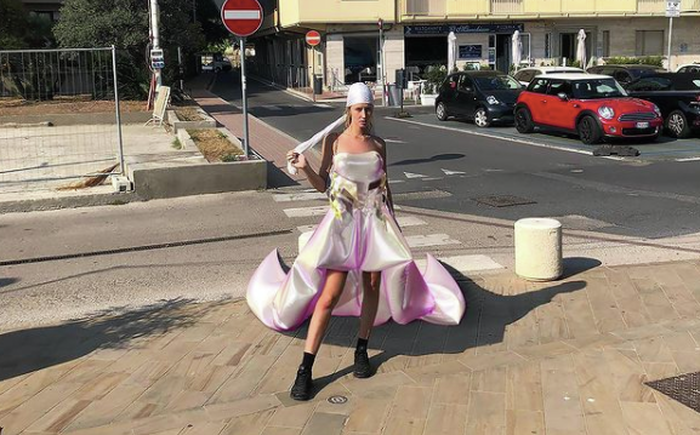Should the fashion industry welcome TikTok?
Creative Contributor Muhammad Syed reflects on his initial misgivings about the viral app and shines a spotlight on the creatives who have made it worthwhile
The age of TikTok is upon us. All hail, Charli D’Amelio.
While I abstain from downloading yet another form of social media, the platform is omnipresent. TikTok videos seep their way onto my Instagram feed. Songs on Spotify go viral because of choreographed dance routines. The world of fashion has been no exception to this trend, inviting the likes of Addison Rae and Noah Beck (names that I have begrudgingly learnt for the sake of this piece) to review runway shows.
My instinctual reaction is to shun the industry for opening the gates of their sacred, exclusive houses to TikTok stars, some of whom evidently have little interest in fashion, when thousands of fledgling, upcoming creatives are not given the same warm welcome. Given the algorithm and business model on which Instagram is predicated, the appeal behind TikTok should be familiar to us by now. Thirsty teenagers lusting over fellow teenagers performing light choreography to the latest songs generate engagement and views, spelling out dollar signs for brands who ride off this clout. Pardon me if I sound condescending but passion or interest or talent does not get you through the front door. Apparently, all it takes is dancing half-naked to the latest Cardi B song.
But I do wonder whether, years ago, a similar blanket of scepticism fell upon the previous generation as the digital age commenced. Were traditional fashion veterans reluctant to embrace bloggers and influencers when they first permeated the fashion scene? I cannot imagine Suzy Menkes or Grace Coddington particularly enjoying being seated next to virtually unknown bloggers. A Forbes piece published ten years ago investigated the rise of the fashion blogger, asking whether the 2010s would be the decade of the influencer. With the gift of hindsight, it seems odd to discuss fashion without considering social media. But there was clearly a sense of doubt which shrouded the industry as it grappled with a total shift in the media landscape. Now, a designer cannot put forward a collection without considering their presence online. Therefore, should we embrace TikTok stars entering the fashion scene? Against my better judgement, my verdict is a (reluctant) yes. Allow me to explain.
“The fashion industry has been democratised on all fronts”
Whether I like it or not, TikTok is here to stay. It has already claimed its territory in fashion, with designers like Hedi Slimane featuring e-boy extraordinaire, Noen Eubanks, in a menswear campaign. Progressive houses, including Ricardo Tisci’s Burberry and Alessandro Michele’s Gucci, have also expressed no hesitation to jump on the bandwagon. The ‘TB’ challenge where users upload a video doing a hand gesture that resembles the Thomas Burberry monogram generated 57 million views for the brand. But why focus this attention on Gen Z when their limited budgets prevent them from actually buying their clothes? As Douglas Greenwood explains for i-D, inviting influencers to enter the world of fashion indirectly also invites millions of future buyers. The generation born post-2000 boasts $140 billion of spending power, helping to explain why some brands are so eager to capture the hearts (and wallets) of the youth.
It would also be remiss of me to ignore the impact of the pandemic on the growth of TikTok. While the world came to a standstill, we had all the time in the world, nothing to do and desperately craved any form of distraction. For a viral platform like TikTok, the time was ripe to capture global attention.
To write off the app as Gen Z garbage would be ignorant of the forces of change that can come from creators. The fashion industry has been democratised on all fronts; TikTok provides a further platform for growing creatives to display their work in hopes that it will land on the right eyes. Take Wisdom Kaye for example, declared the best dressed guy on TikTok by Vogue, whose innovative styling has landed him contracts with IMG models and WME, a highly coveted agency. In addition, for a POC creator like Milan Mathew, she viewed the app as a way to revel in her culture. In the #FashionEdit challenge, where users begin by wearing casual clothes before transitioning into a video of themselves dressing to the nines, she decided to wear a lehenga, an Indian traditional outfit. Her TikTok now boasts over 11 million views and has sparked a frenzy of POC embracing their heritage.
Despite my initial apprehension, I am all for the platform if it means a further democratisation of the industry. For every review of the AW/21 Louis Vuitton show that Noah Beck describes as ‘so sick’ and ‘popping off’, there stands another deserving creator whose styling or art garners thousands of views that it wouldn’t have had without TikTok.
So when 3rd June — the date of my last exam — comes around, I intend to step foot into the world of TikTok. For the minority of you not already on the platform, I hope you will join me too.
 News / SU stops offering student discounts8 January 2026
News / SU stops offering student discounts8 January 2026 News / Uni-linked firms rank among Cambridgeshire’s largest7 January 2026
News / Uni-linked firms rank among Cambridgeshire’s largest7 January 2026 Comment / Plastic pubs: the problem with Cambridge alehouses 5 January 2026
Comment / Plastic pubs: the problem with Cambridge alehouses 5 January 2026 News / New movement ‘Cambridge is Chopped’ launched to fight against hate crime7 January 2026
News / New movement ‘Cambridge is Chopped’ launched to fight against hate crime7 January 2026 Comment / What happened to men at Cambridge?31 December 2025
Comment / What happened to men at Cambridge?31 December 2025









